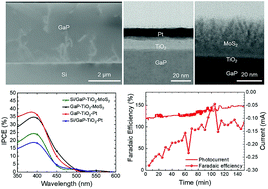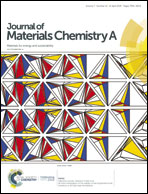Heteroepitaxy of GaP on silicon for efficient and cost-effective photoelectrochemical water splitting†
Abstract
Photoelectrochemical production of hydrogen by using sunlight to split water offers a sustainable approach for clean energy generation. III–V semiconductors have shown the highest efficiencies for photoelectrochemical water splitting but the prohibitive cost of commercial single-crystalline GaP wafers limit practical use and large-scale application. Here, we report a high-quality GaP photocathode directly grown on a silicon substrate by solid-source molecular beam epitaxy. The photocathode can be stabilized under acidic electrolyte 1 M HClO4 (pH 0) by combining an amorphous TiO2 layer coated with a molybdenum sulphide MoS2 hydrogen evolution catalyst by atomic layer deposition (ALD). Under simulated AM 1.5G solar illumination, the Si/GaP photocathode yielded a maximum photocurrent density of 0.95 (mA cm−2) with a proton reduction onset potential of 467 mV versus the reversible hydrogen electrode. The average faradaic efficiency of the Si/GaP photocathode was measured to be over 73.4 ± 20.2% for over 100 minutes. The photoelectrochemical studies for the Si/GaP photocathode show the potential for widespread deployment of cost-effective photoelectrodes for hydrogen generation.



 Please wait while we load your content...
Please wait while we load your content...
